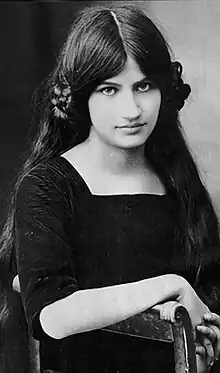Jeanne Hébuterne
Jeanne Hébuterne (French pronunciation: [ʒan ebytɛʁn]; 6 April 1898 – 26 January 1920) was a French painter and art model best known as the frequent subject and common-law wife of the artist Amedeo Modigliani. She took her own life two days after Modigliani died, and is now buried beside him.
Jeanne Hébuterne | |
|---|---|
 | |
| Born | 6 April 1898 |
| Died | 26 January 1920 (aged 21) |
| Occupation(s) | Painter, model |
| Partner | Amedeo Modigliani (1917–1920; his death) |
| Children | Jeanne Modigliani |
| Relatives | André Hébuterne (brother) |
Early life
Jeanne Hébuterne was born in Meaux, Seine-et-Marne, the second child to Achille Casimir Hébuterne (born 1857), who worked at Le Bon Marché, a department store,[1] and Eudoxie Anaïs Tellier Hébuterne (born 1860).[2][3] The family was Roman Catholic.
A beautiful girl, she was introduced to the artistic community in Montparnasse by her brother André Hébuterne, who wanted to become a painter. She met several of the then-starving artists and modeled for Tsuguharu Foujita.[4]
Wanting to pursue a career in the arts, and with a talent for drawing, she chose to study at the Académie Colarossi, where in the spring of 1917 Hébuterne was introduced to Amedeo Modigliani by the sculptor Chana Orloff, who came with many other artists to take advantage of the academy's live models.
Jeanne began an affair with the charismatic artist, and the two fell deeply in love. She soon moved in with him, despite strong objections from her parents.[5]
Life with Modigliani


Described by the writer Charles-Albert Cingria (1883–1954) as gentle, shy, quiet, and delicate, Jeanne Hébuterne became a principal subject for Modigliani's art.
In the spring of 1918, the couple moved to the warmer climate of Nice on the French Riviera where Modigliani's agent hoped he might raise his profile by selling some of his works to the wealthy art connoisseurs who wintered there. While they were in Nice, their daughter, Jeanne Modigliani, was born on 29 November.
The following spring, they returned to Paris and Jeanne became pregnant again. By this time, Modigliani was suffering from tuberculous meningitis and his health, made worse by complications brought on by substance abuse, was deteriorating badly.[6]
Death

On 24 January 1920, Modigliani died, when Jeanne was eight months pregnant with their second child. Hébuterne's family brought her to their home, but she threw herself out of the fifth-floor apartment window the day after Modigliani's death, killing herself and her unborn child, a son.[5][7][8]
Her family, who blamed her demise on Modigliani, interred her in the Cimetière de Bagneux. Nearly ten years later, at the request of Modigliani's brother, Emanuele, the Hébuterne family agreed to have her remains transferred to Père Lachaise Cemetery to rest beside Modigliani.
Her epitaph reads: "Devoted companion to the extreme sacrifice."[5]
Legacy

Their orphaned daughter, Jeanne Modigliani (1918–1984), was adopted by her father's sister in Florence, Italy. She grew up knowing virtually nothing of her parents and as an adult began researching their lives.[6] In 1958, she wrote a biography of her father that was published in the English language in the United States as Modigliani: Man and Myth. ISBN 1-199-15698-1
It took more than thirty years before an art scholar persuaded the Hébuterne heirs to allow public access to Jeanne Hébuterne's artwork. In October 2000, her works were featured at a major Modigliani exhibition in Venice, Italy by the Fondazione Giorgio Cini.[5][9]
It was revealed in January 2010 that the works presented at the exhibition were forged. Christian Parisot, the curator of the exhibition, had been accused by Hébuterne's grandnephew of faking 77 drawings. He was sentenced to a two-year suspended sentence and a €50,000 ($70,000) fine by a French court of appeals.[10]
Gallery
Works by Jeanne Hébuterne
 Natura morta
Natura morta Self portrait, 1916
Self portrait, 1916
Works by Modigliani featuring Hébuterne
 Portrait of Jeanne Hebuterne by Amedeo Modigliani
Portrait of Jeanne Hebuterne by Amedeo Modigliani_MET_DT2180.jpg.webp) Jeanne Hébuterne by Modigliani, 1919
Jeanne Hébuterne by Modigliani, 1919 1918
1918
References
- "Jeanne Hebuterne (1898–1920)". Galerie André Roussard. Archived from the original on 16 August 2017. Retrieved 1 July 2008.
- "Eudoxia Anaïs Tellier Hébuterne". geni_family_tree. 16 August 1889.
- "Family tree of Eudoxie Anais TELLIER". Geneanet.
- Jiminez, Jill Berk (2001). "Hébuterne, Jeanne: French, 1898–1920". Dictionary of Artists' Models. Chicago: Fitzroy Dearborn. pp. 269–272. ISBN 978-1-57958-233-3.
- Lappin, Linda (22 June 2002). "Missing person in Montparnasse: The case of Jeanne Hebuterne". Literary Review. 45 (4): 785–811. Archived from the original on 10 June 2014.
- "An Introduction to Art History". Amedeo Modigliani. Archived from the original on 22 June 2008. Retrieved 1 July 2008.
- "Visionneuse – Archives de Paris". archives.paris.fr.
- Fifield, William (1976). Modigliani. New York: William Morrow and Company. pp. 281–282. ISBN 0688080391.
- "Modigliani e i suoi: Jeanne Hébuterne, André Hébuterne, Georges Dorignac, Amedeo Modigliani". Edited by Christian Parisot. Venice: Fondazione Giorgio Cini/Canale Arte. 2000. Retrieved 15 December 2013.
{{cite web}}: CS1 maint: others (link) - Hurwitz, Laurie (26 January 2010). "Paris Art Expert Sentenced in Drawing Forgery Case". ARTnews. Retrieved 1 October 2016.
External links
 Media related to Jeanne Hébuterne at Wikimedia Commons
Media related to Jeanne Hébuterne at Wikimedia Commons